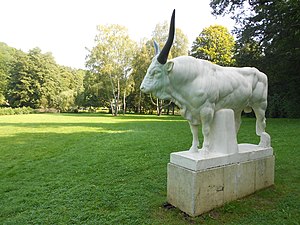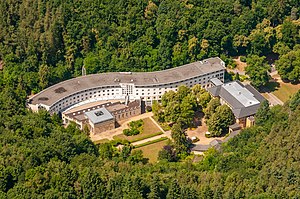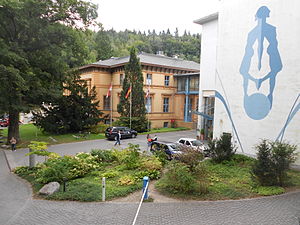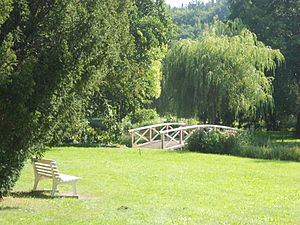Specialist clinic and mud bath in Bad Freienwalde
| Specialist clinic and mud bath in Bad Freienwalde | |
|---|---|
| Sponsorship | Specialist clinic and mud bath Bad Freienwalde GmbH |
| place | 16259 Bad Freienwalde (Oder) , Gesundbrunnenstrasse 33 |
| state | Brandenburg |
| Country | Germany |
| Coordinates | 52 ° 46 '28 " N , 14 ° 1' 16" E |
| Manager | Angela Krug |
| beds | 220 |
| Employee | 125 |
| areas of expertise | Rehabilitation: orthopedics , rheumatology and osteology |
| Affiliation | Hospital Märkisch-Oderland GmbH, Strausberg |
| founding | 1684 |
| Website | www.reha-freiwalde.de |
The specialist clinic and mud bath Bad Freienwalde is located on the outskirts of Bad Freienwalde (Oder) in Brandenburg . It is a rehabilitation clinic for orthopedics , rheumatology and osteology and the oldest spa in Brandenburg.
history
Or god Viadrus
After the Vistula Ice Age , the first people immigrated to the area. Bronze Age shards were found between Falkenberg and Hohenfinow near Liebenstein .
As early as around the year 1000, fishermen settled in what is today the urban area of Bad Freienwalde near what is now Altkietz. At that time, a broad tributary of the Oder flowed directly past the hill that is now called the “Berliner Berg” and on the edge of which is the mud bath.
Around 1200 Slavs from the Ukrani tribe settled in the glacial valley. The Uckermark region to the north has been named after them since the Middle Ages . The annually recurring floods of the Oder deposited mud and minerals from the Jizera Mountains in what is now Freienwalde. The deposits took place on the southwest bank of the river bed at that time, on the edge of the glacial valley and northwest of today's city of Bad Freienwalde. The Alte Oder shifted its river bed further and further north-east over the centuries, and erosion residues from the Barnim plateau accumulated on the silt layers. Since the layers below are relatively impermeable to water, the bog has been kept moist by layers of water to this day.
The legend of Viadrus , god of the Oder, is reported from an unknown ancient time. He was lying on an island in the Oder and had his body covered with black mud by mermaids with fish undersides. The old man said: “You can still moor jewen!”. Two of the water women talked about how the old man would be relieved of his back pain. Fishermen observed the Oder god and the mermaids and allegedly already in ancient times relieved their knee problems, which result from long standing in the water, by brushing them with mud.
middle Ages
In 1231 the monastery town of God "Civitas Dei" was founded in the Slavic town of Barsdin (today Oderberg). This monastery was a foundation of the Premonstratensian order with the mother monastery Brandenburg an der Havel. Barsdin was the eastern, Slavic part of the later town of Oderberg. The settlement of the city began between 1208 and 1215 by Slavs, who built the first princely castle on the Albrechtsberg. With the construction of the monastery, the Brandenburg claims to this area were to be consolidated. The Ascanians settled on the heights south of the Eberswalde glacial valley , the now insignificant village of Hohenfinow was fortified with a castle and one of the northernmost settlement points. Today's Bad Freienwalde, a few kilometers away, was still a small Slavic fishing village at the time.
The deed of foundation clearly shows that the monastery was intended to host pilgrims, sick people and refugees. Therefore, a hospital was attached to the monastery, which was founded a few years earlier. As far as we know today, the place was divided for a long time. To the west of the Behnitz river was the monastery, to the east the village of Barsdin, which the margraves Johann I and Otto III. Donated to the monastery in 1231. “The hospital, on the other hand, existed in Barsdyn until 1372,” so a Slavic village continued to exist for at least 150 years under Ascanic ownership of the Chorin monastery. In 1786, the historian Friderich Ludewig Joseph Fischbach documented the existence of remains of the hospital in his statistical-topographical city descriptions of the Mark Brandenburg , today there are no more archaeological finds. At that time, Freienwalde, 10 km away, was already a well-known health resort.
Kurfürstenquelle
The first documented mention of Freienwalde comes from the year 1316, but from the 13th to the 17th centuries Oderberg and Hohenfinow were the most important cities in the area. The Chorin monastery had properties up to near Freienwalde, which remained a small village. It was not until 1683 that the healing spring was discovered and described by Bernhard Friedrich Albinus in 1685 (today "Kurfürstenquelle") that laid the foundation for the development of the place into a spa town.
The Freienwalder pharmacist Gensichen examined the water and certified it in 1683 as having a "mineral content". The Berlin alchemist and glassmaker Johann Kunckel reports to Elector Friedrich Wilhelm (Great Elector) of the discovery of the spring, and the first spa is organized.
The Great Elector sought relief for his gout complaints at the spring in Freienwalde in 1684, which is considered to be the year the spa was founded. In 1706, King Friedrich I of Prussia took a liking to the spa in Freienwalde, and had Andreas Schlueter build a pleasure palace in the village. The "soldier king" Friedrich Wilhelm I had the fountain expanded in 1733 due to the healing of several military personnel. King Friedrich Wilhelm II visited the Gesundbrunnen in 1788 and then made extensive funds available for expansion. This requires a period of economic and cultural heyday of the spa and the city for about 20 years.
In 1797 Queen Friederike Luise von Hessen-Darmstadt chose Freienwalde as her retirement home and had a lodging house built for her in 1790 and later, by David Gilly, the Freienwalde Palace , which still exists today.
After the death of Queen Friederike Luise and the lost battle near Jena and Auerstedt on October 14, 1806, Prussia was severely weakened. On October 27th, Napoleon entered Berlin after the Prussian King Friedrich Wilhelm III. fled to East Prussia with his family and court .
As a result, the bathroom fell into disrepair and was run down in a few years. It was not until 1818 that a multi-part ballroom was built based on a design by Karl Friedrich Schinkel . Freienwalde and its Gesundbrunnen developed into a fashionable spa for well-to-do bathers. In 1832 the city bought the Gesundbrunnen for 15,000 thalers.
Today used as a mud bath
today's specialist clinic and mud bath


The healing spring is no longer used therapeutically today. The Kurfürstenquelle, which was expanded in 1900, is often used as a water supply, also outside the clinic. In the vicinity of this source, which is fed by pumps, there are other sources of mineral water.
The moor, which was mined nearby, has been used as a remedy since 1840. The moor is fed back into the natural cycle, after bathing it is collected and returned to the extraction sites.
In 1951/52 a bathhouse and the moor treatment plant were built next to Schinkel's ballroom; these buildings were demolished in 1961 and 1992/93. In the 19th century, the noble, noble spa guests could bathe directly in their rooms, the "commoners" used a bathhouse with large wooden tubs. There was also a church and apartments for the servants on the premises of the spa.
From October 23, 1925, the place had the official designation bath in its name, and on December 15, 2003 it was finally recognized as a mud spa, which was confirmed in May 2012. From 1934 Jews were forbidden to stay in the baths and in the city, and in 1942 the spa was converted into a hospital . After the end of the war in 1945, the Red Army occupied the baths in Gesundbrunnenstrasse, and in 1952 the baths were resumed as the "bathing people of the working people". For almost 40 years, mainly miners from the Lusatian lignite mining areas and members of the Ministry of the Interior were treated.
At the turn of the century, the standard of equipment was far below the German standard; extensive modifications and reconstructions as well as investments were necessary. At the beginning of 1991, the city received the spa properties back from the Treuhandanstalt . The spa was re-established in 1991 as the AHG Klinik und Moorbad Bad Freienwalde . In 2012 it was taken over by the Märkisch-Oderland GmbH hospital from Strausberg.
Today's clinic treats diseases of the skeleton, muscles and connective tissue, including inflammatory rheumatic diseases, as well as metabolic diseases that affect the musculoskeletal system. Light , electrical , physical and occupational therapy , a therapy bath and a sauna are available to patients .
literature
- Author collective: contemporary stories. Preservation of monuments in Brandenburg. Choriner Chapter, Issue 140, 2005, ISBN 3-936932-07-7 .
- Max Burkhardt, Bad Freienwalde / Oder: Bad Freienwalde (Oder) the mud bath of Berlin. Reprint of 1926 brochure, 242nd season.
- Wolfgang Erdmann : Cistercian Abbey Chorin. History, architecture, cult and piety, prince claims and self-portrayal, monastic economics and interactions with the medieval environment. With the collaboration of Gisela Gooß, Manfred Krause u. Gunther Nisch. Koenigstein i. Ts. 1994 (= The Blue Books), ISBN 3-7845-0352-7 .
- Heiko Walther-Kampf, Ernst-Otto Denk: Viadrus Heimatbuch für Bad Freienwalde (Oder) and surroundings et Terra Transoderana , 3rd year 2011, Bad Freienwalde Tourismus GmbH.
- Manfred Krause: A village in the shadow of the monastery - The village of Chorin in the Middle Ages 1258–1575. Choriner Chapter, Issue 200, ISBN 3-936932-06-9 .
- Ullrich Künkel: Bad Freienwalder Lexikon , 1st edition, Rinteln 1994.
- Frank Margelsdorf (ed.); Märkische Oderzeitung: Bad Freienwalde then and now , Edition Brandenburg, texts: Reinhard Schmook, photos: Hannelore Siebenhaar u. a. ISBN 978-3-941092-30-3 .
- Wolf Russow, Nadine Jentzsch: Chronicle of the Mariensee Monastery 1258–1273–2007. ISBN 3-936932-13-1 .
- Wolfgang Ribbe : On the religious policy of the Ascanians. Cistercians and sovereignty in the Elbe-Oder region. In: Cistercian Studies I (= Studies on European History 11), Berlin 1975, pp. 77–96.
- Winfried Schich: Monasteries and cities as new central places of the high Middle Ages in the area east of the middle Elbe. In: Karl-Heinz Spieß (Hrsg.): Landscapes in the Middle Ages. Stuttgart 2006, pp. 113-134.
- Reinhard Schmook: Bad Freienwalde (Oder), the series archive images. Sutton Verlag, Erfurt, ISBN 3-89702-872-7 .
- Reinhard Schmook: Bad Freienwalde (Oder), A journey through pictures into the past of the oldest spa town in Brandenburg . 1st edition. Geiger-Verlag, Horb am Neckar 2005, ISBN 3-86595-068-X .
- Oskar Schwebel: Chorin Monastery. In: Richard George (Hrsg.): Hie good Brandenburg all way! Historical and cultural images from the past of the Mark and from old Berlin up to the death of the Great Elector. W. Pauli's Nachf., Berlin 1900 Digital edition online .
- Anna Teut : Bourgeois, Royal - Walther Rathenau and Bad Freienwalde. Transit Buchverlag 2007, ISBN 978-3-88747-174-3 .
- Memorandum for the 100th anniversary of the fountain at the Kurfürstenquelle issued by the specialist clinic.
- Karl-Friedrich Hinkelmann: Bad Freienwalde - oldest Brandenburg spa. In: Die Mark Brandenburg , Issue 89, 2013, pp. 8-17.
Web links
Individual evidence
- ↑ bad-freiwalde.de : Moor and more
- ↑ a b Ernst-Otto Denk: How Freienwalde became famous for its moor. in: Heiko Walther-Fights, Ernst-Otto Denk: Viadrus Heimatbuch for Bad Freienwalde (Oder) and the surrounding area et Terra Transoderana. 3rd year 2011, Bad Freienwalde Tourismus GmbH.
- ↑ Wolf Russow, Nadine Jentzsch: Chronicle of the Mariensee Monastery 1258–1273–2007 . ISBN 3-936932-13-1 , p. 5 ff.
- ↑ Paul Eichholz: The art monuments of the Angermünde district. Book III Chorin Monastery, Vossische Buchhandlung, Berlin 1927, p. 165
- ^ Brandenburg-info.com : Bad Freienwalde health resort
- ^ Prussian royal castle Freienwalde : history
- ↑ Oderland in the past and present: ignorance of architectural value. Märkische Oderzeitung , August 25, 2011.
- ↑ Milestone for a recognized spa. In: Märkische Oderzeitung , May 3, 2012.
- ↑ 20 years of the AHG clinic and mud bath in Bad Freienwalde. ( Memento of the original from November 28, 2009 in the Internet Archive ) Info: The archive link was inserted automatically and has not yet been checked. Please check the original and archive link according to the instructions and then remove this notice. State of Brandenburg, Ministry for the Environment, Health and Consumer Protection, June 10, 2011

















